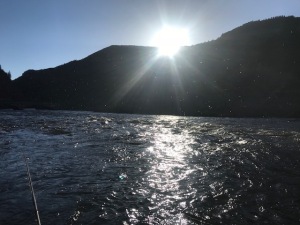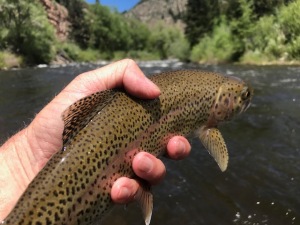Hidy Ho Good Neighbors,
It was my eleventh summer and a group of my neighborhood buddies and I pooled our resources and engineering prowess to construct a very fine tree fort. This fort had everything, windows that opened and closed, quick exit trap doors, radio antennae, and a rope ladder. We were kings of the tree tops.
Our inaugural sleep-in night was upon us and just after we settled in for the evening someone tossed a lit smoke-bomb into our abode. I remember clicking on my flashlight and being surrounded by stinky blue smoke. We bailed out as quickly as possible, but the night was ruined. All that preparation and anticipation went right down the tubes. We were ticked.
I thought about the smoke-bomb incident the other day as I was standing in a well-known front range tailwater. I spend a lot of time guiding other fly fishers and every so often; I get to hit the river by myself, which is always a treat. I plan, re-rig my fly rods, spin a few special flies, and no matter how tired I am from the weeks work, I’m always up early and anxious to go.
I arrived much earlier than the other anglers, and had settled into a favorite run. This run has room for one angler, is choked with willows on the anglers backcast, and the perimeters can be easily reached with a decent roll cast. In other words, it’s a small section of river that a modest fly caster can cover top to bottom and bank to bank, without moving an inch.
I had settled in, and put a couple small rainbows and one decent brown trout in the bottom of my net in around fifteen minutes. I smiled to myself after landing the last fish, relaxed a bit, and lit my pipe. Just then, I hear splashing below me in the run as two anglers step into the drink. They both look at me as I angle my head to the side, hitting them with a “What are you going to do?” non-verbal cue. One of the guys stops in his tracks, the other proceeds to place a roll cast into my run while trying to avoid eye-contact. His first cast, had I been in a drift, would have crossed my line!
I turned facing him and uttered, “Really, this is the best you can do?” He didn’t say a word, backed out and took his partner with him. I stood there for a minute shaking my head. I stripped out some line and readied for my next upstream presentation, when all of a sudden, those two knuckleheads bust through the willows on the bank above me, waded in, and began to fish. I could have easily cast over both of their lines. Smoke-bomb in the tree house!
I rigged up my rod and slogged over to the bank. Just before leaving I reminded them that they needed to learn some manners, and mentioned something about trout in public places, and we not only need to respect the fish, but the fishermen as well. They heard me but neither had the courage to make eye contact. I’m still pissed.
The majority of anglers know fishing etiquette. Always ask folks which way they plan to fish, upstream or downstream, give them plenty of room, and extend to them the same courtesy you would expect from others. Don’t walk the banks above an angler working a run. That’s a good way to spook fish he is working. Always try to give them the run they’re in and the shelf above it. I’ll often ask if it’s ok to hit the run above them, if it’s a good distance above the shelf that marks the top of their run.
Maybe that’s part of it, folks don’t know how to read the river, which gives them no discernable start and stop places. Maybe they simply need to learn a typical run; riffle, shelf, pool, glide, tailout, riffle. Frankly, I’m not confident that will solve the issue, this comes down to a “me first” mentality. An ”I need this fish picture for my social media”, mentality. Yep, I’m still a little pissed.
I am more than annoyed at what fly fishing has become on our crowded rivers in Colorado. So many anglers, packed into a few miles of rivers. Still, I think with a healthy dose of etiquette, we could have fun days even on highly pressured waters. I have been preaching fishing etiquette for as long as I can remember, and there are days when it’s certainly more than annoying, but we have to keep teaching protocol one angler at a time. Fear No Water!




Duane-
Saw your video on how to hook, play and land a trout – very cool.
I thought I’d reach out to you and seek your advice.
I consider myself to be a pretty good trout fisherman that mostly fishes Brookies, Rainbows and Browns in the UP of Michigan and Southwest Wisconsin.
I also have done a fair amount of fishing in Colorado and recently Idaho.
Lately, I’ve been fortunate enough to hook into some 18” plus fish but have run into a bad streak of having the fly pop out. (Big ones – 12 and under NP)
Most of my misfortune happens because the fish takes off downstream in fast rocky water and I can’t follow them down without risking serious injury.
When I try and hold them up, they spit the hook.
( maybe I should turn the rod more to a lateral position?)
So – how do I bring a running fish in close when he’s downstream in faster, rocky water without pulling yet another damn hook out of their mouth.
The last eight big trout I’ve lost have been browns and large cut-throats. Again – smaller fish NP.
Thanks Duane.
Bob Clark
Sales Consultant
BD Preanalytical Systems (Vacutainer)
630-561-6042
bob.clark@bd.com
http://www.bd.com
Hey Bob,
We have similar issues on the Eagle River. Lots of stuff to trip over and on makes chasing fish unsafe. Yep, you’re right, try to get a solid edge, or lateral position. It’s not unusual for my clients to have to lay the fly rod parallel to the water on the bank side. I find the main problem to be when the fish begin to roll on the surface facing the angler, this forces the hook free. I instruct that any time the fish elevates and rolls on the surface to find an edge and lay the rod flat to the water til the fish submerges. After the fish drops in the columns, bring the rod up to the appropriate angle and resume your battle.
Big fish are also suited to outrun your drag and tippet strength as they motor downstream. It’s a real dilemma as you try to let them go or hold them up depending on what’s below you downstream. Fly fishing is mostly science, but a good dose of art is needed to land the fish you talk about in the conditions you outline. Make sure your fly rod is in a high position as they run to relieve tippet pressures, that your drag is set correctly, that your rod, reel, and arm are perfectly aligned, and that you attain those edges quickly. Don’t keep the rod in one position too long, you need to match the fish move for move. Many folks simply freeze.
Had a brute on yesterday in exactly the conditions you describe, and was able to land her only because I scooted 30 yards below the angler and scooped her in a soft seam next to the bank. Most often, it takes two for fish in those conditions. You can be much more aggressive than you think if you have the proper rod angles. Once you begin to get control, continue to work the fish into the softest water as you take in line. Be aware the fish is going to make three solid runs on average, so don’t be on the reel when she runs. Work to the soft stuff below you, move carefully if you can once you’re in control, find an edge as she rolls on the surface, and try to control the head.
Have you thought of increasing tippet size?
Honestly, it’s a good problem to have, but it does get frustrating to have only a knife at a gunfight.
Lemme know if this helps!